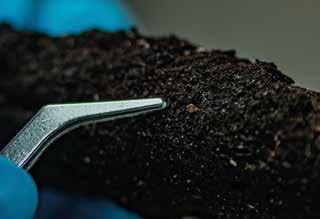
3 minute read
Case study – Bid to rescue Madeira’s lost snails
This year has seen Chester Zoo make a major contribution to preventing the extinction of a number of snails endemic to islands around Madeira. Madeira, an autonomous region of Portugal, is an archipelago of islands in the Atlantic Ocean about 320 miles off the coast of Morocco. This isolation, just like its distant neighbour the Canary Islands, has resulted in the evolution of many unique endemic species. Among these are a number of snails that are found nowhere else on Earth, and have been driven right to the edge of extinction by loss of habitat and invasive species colonising the isolated islands.
Chester Zoo has been tackling similar challenges with the species of Bermuda for a number of years, and it was this experience and proven results that resulted in a contact to request our assistance with saving the snails of Madeira. Initially we have set a target to work with five of these species that are right on the edge of extinction, with goals to both start the species’ preservation programmes to breed the snails in captivity and then population restoration programmes to increase the numbers and range of the five snails in the wild. In summer 2021, we began by receiving snails of two different species collected from Desertas Grande Island (one of the Madeiran islands) – 36 Discula lyelliana and 81 Geomitra grabhami snails arrived at the zoo from the Madeiran government. Both species are critically endangered, with Discula lyelliana even feared to already be extinct prior to the collection of the snails, and the best estimates for Geomitra grabhami assessing the population as fewer than 500 snails are left. Receiving such precious species, it was our immediate action to divide the populations of both species between ourselves and the care of colleagues at Bristol Zoo – a safeguard just in case unforeseen events occurred. From these starting populations at Chester Zoo of just 18 and 42 snails respectively, our teams immediately set about trying to replicate the wild microhabitat of the snails and provide all the necessary resources and conditions for them to thrive – the first time these species have ever been kept out of their natural environment.
Seven months later, under the care and expertise of our invertebrate keepers, we now hold populations of 2,362
Left main image ref XX. Right main image ref XX.
STRATEGIC REPORT


Discula lyelliana and 935 Geomitra grabhami – a staggering 6,500% and 1,150% increase in the population of those snails that originally arrived at the zoo back in June 2021. These initial successes were so encouraging that at the end of 2021 there was an expedition again to Desertas Grande Island involving both our own zoo staff and the Madeiran government, in search of some of the other almost extinct species. We were delighted that this yielded 37 specimens of a third critically endangered endemic snail, Atlantica calathoides – a species believed to possibly be down to a population as low as just 50 individuals!
The coming year will see our experts at the zoo starting to plan the first conservation translocations of some of these snails back to their native Desertas Grande Island to help restore the wild populations – working hard to continue our breeding successes with Discula lyelliana and Geomitra grabhami and extend these to Atlantica calathoides as well, and hoping to save the two still elusive species Geomitra coronula and Geomitra moniziana by collecting snails and founding species preservation programmes for them both.

Sustainable Development Goals:
Our work with Madeira’s lost snails supports SDG 15 (Life on Land)








